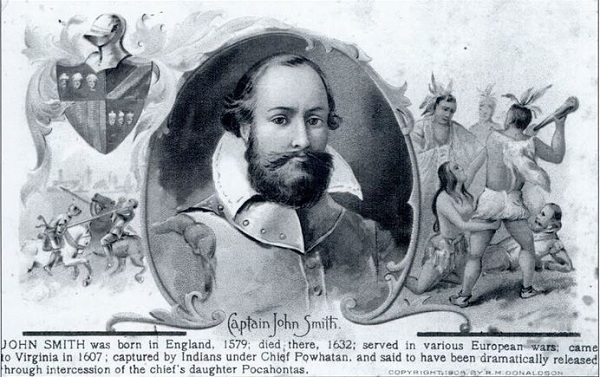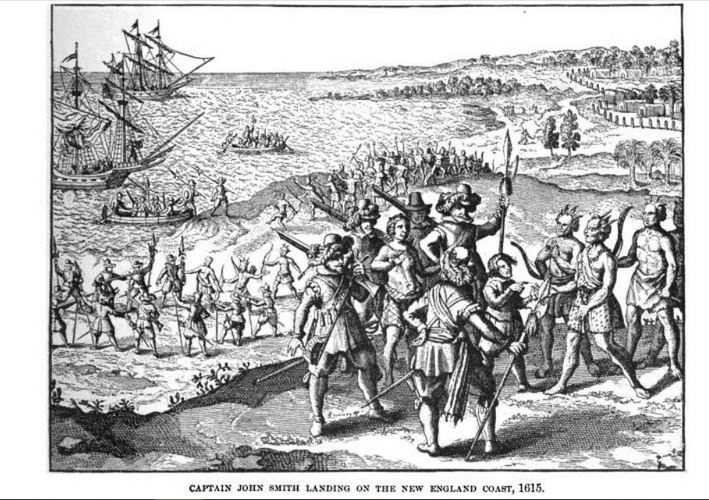Captain John Smith was an English explorer who helped settle the colony of Jamestown and also explored New England in 1614 with plans to colonize the region.
He lived a wildly adventurous life and wrote a total of eight books about his experiences. Some of Smith’s adventures include the time he served as a mercenary in two separate armies, the time he was captured and sold into slavery, the time he was saved by two princesses on two separate occasions as well as the numerous times he was imprisoned and nearly hanged.
The following is a timeline of the life of Captain John Smith:
1580:
In January, John Smith is born to Alice Rickard and George Smith at Covell’s Farmhouse in Willoughby, England. George was a yeoman farmer who rented Covell’s farm in Willoughby.
On January 6, John Smith is baptized in the parish church in Willoughby.
1592:
Smith begins attending King Edward VI grammar school.
1595:
Smith’s education at King Edward VI grammar school ends and he is apprenticed to a prominent merchant, Thomas Sendall, at King’s Lynn.
1596:
In early April, his father, George Smith, dies.
John Smith leaves his apprenticeship and instead uses the money from his inheritance to travel to London, Orleans, Paris, Rouen and Havre.

Later in the year, Smith becomes a mercenary in the French Army.
1596-1599:
Smith becomes a mercenary in the Dutch Army to fight for the Netherlands in its war of independence from Spain.
1599:
Smith returns to England.
Smith spends two years reading classical military texts and studying horsemanship.
1600:
Smith travels to Enkhuizen in the Netherlands.
Smith is thrown overboard by four Frenchmen, who superstitiously blame him for the bad weather they experience while on their way to Scotland, and he washes ashore at Holy Island, or Lindisfarn. He is rescued by Captain La Roche of Saint Malo, a French privateer, and spends four months at sea as a part of his crew.
Smith parts ways with La Roche and travels around Italy.
1601:
Smith travels to Hungary and becomes a mercenary for the Austrian forces in their fight against the Ottoman Empire.
Smith is promoted to captain while fighting for the Austrian Hapsburgs in Hungary.
1602:
Smith travels to Transylvania, Wallachia and Turkey with the Austrian forces.
Smith is wounded and captured at the Battle of Rottenton and is sold into slavery.
Smith is purchased by a Turkish nobleman, who gifts him to his Greek mistress in Constantinople, Princess Charatza Tragabigzanda. The princess ultimately falls in love with Smith and sends him to her brother for training to join the Turkish imperial service.
Smith escapes by murdering the brother and fleeing through Russia and Poland.
1603:
Smith travels to Constantinople, the Black Sea, Niger, Serbia, Hungary and Germany.
1604:
Smith travels from Germany to France, Spain, Gibraltar and Africa.
1605:
In the winter, Smith returns to England.
Smith travels throughout Ireland and travels to South America
1606:
Smith becomes involved in the Virginia Company’s plans to colonize Virginia.
On December 20, 1606, Smith sets sail on the Susan Constant, one of three small ships, headed on an expedition led by Christopher Newport to Virginia.
During the four month journey, Smith is charged with mutiny by the leader of the expedition, Captain Christopher Newport, and is imprisoned on board the ship and nearly hanged.
1607:
In April, the ships reach Virginia and Smith is released when the other colony leaders receive orders from the Virginia Company and discover Smith is designated to be one of seven governing council of the colony.
On May 14, the expedition ends when Captain Edward Wingfield chooses Jamestown as the new colony.
In December, Smith and his crew are ambushed by a large Powhatan hunting party while searching for food sources along the Chickahominy River. Smith is the only survivor and is brought to Chief Powhatan, at Werowocomoco, who reportedly attempts to kill him but is thwarted when 11-year-old Pocahontas throws herself on top of Smith and shields him with her body (Note: Some historians doubt Smith’s version of the story and believe he may have been a part of an adoption ceremony but that Smith misunderstood what was happening.)
After four weeks at Werowocomoco, Smith returns to Jamestown in January after having formed a friendship with the Powhatan people.
When Smith returns to Jamestown, he discovers he has been replaced on the local council because the colonists believe he was responsible for his crew’s death. He is sentenced to hang but after the sudden arrival of 100 new settlers to the colony on the night of his sentencing the issue is dropped.
The Virginia Company sends Smith on two lengthy expeditions to explore the Chesapeake in search of gold and a passage to the Pacific Ocean. He finds neither but does secure food for the colonists and creates highly accurate maps of the area.
1608:
On September 10, Smith is elected president of the local council in Jamestown.
Smith’s book titled A True Relation of Such Occurrences and Accidents of Note as Hath Happened in Virginia is published.
1609:
During the summer, Smith is demoted to running a remote lookout garrison.
In September, Smith is badly burned when a gunpowder bag Smith is sleeping on accidentally ignites. Smith describes the incident as an accident but some historians believe it was a failed murder plot.
In October, a severely burned Captain John Smith leaves Jamestown for good.
1612:
Smith’s book titled A Map of Virginia: With a description of the Country, the Commodities, People, Government and Religion is published.
1614:
In April, Smith arrives in New England on his one and only trip to the region to hunt whales and search for gold on behalf of the Plymouth Company but also planned to scout for a location for a new colony. Smith names the area New England.

One of Smith’s lieutenants, Captain Thomas Hunt, manages to capture a number of Native-Americans during the expedition, without Smith’s knowledge or approval, and takes them back to Europe to sell as slaves. One of these Native-Americans turns out to be Squanto.
In late August, Smith returns to England having made a small profit through furs and fish.
1615:
In March, Smith attempts to return to New England to establish a colony but is thwarted when a storm heavily damages his two ships.
In June or July, Smith sails from Plymouth, England to make another attempt to return to New England but is captured by pirates off the coast of Azores.
A few months later, Smith escapes by sneaking off in a boat during a storm.
Smith returns to England and publishes his account of his travels in New England.
1616:
Smith’s book titled A Description of N. E. is published.
1617:
In January, Smith is offered a fleet of ships for an expedition to New England.
In March, Smith’s fleet of three ships are unable to leave port due to a southwester that blew for three months. Smith eventually abandons his plans and returns to London.
1624:
Smith’s book titled The General History of Virginia, New England, and the Summer isles is published.
1626:
Smith’s book titled An Accidence or The Path-Way to Experience is published.
1630:
Smith’s book titled The True Travels, Adventures, and Observations of Captain Iohn Smith, in Europe, Asia, Africa, and America from Anno Domini 1593 to 1629 is published.
1631:
Smith’s book titled Advertisements for the Unexperienced Planters of New-England, or Anywhere is published.
On June 21, John Smith dies in London, England at the age of 51 and is buried at St. Sepulchre’s church.
Sources:
“John Smith.” Historic Jamestowne, historicjamestowne.org/history/pocahontas/john-smith
Hindley, Meredith. “Soldier of Fortune: John Smith Before Jamestown.” National Endowment for the Humanities, neh.gov/humanities/2007/januaryfebruary/feature/soldier-fortune-john-smith-jamestown
“Covell’s Farm House.” British Listed Buildings, britishlistedbuildings.co.uk/101204983-covells-farm-house-willoughby-with-sloothby
Captain John Smith of Willoughby by Alford, Lincolnshire: President of Virginia; and the Admiral of New England, Part 1. Edited by Edward Arber, Archibald Constable and Co, 1895.
A Description of New England (1616)
A True Relation of Such Occurrences and Accidents of Noate as Hath Hapned in Virginia (1608)
Letter from Captain John Smith to Queen Anne (1617)
The Generall Historie of Virginia, New-England, and the Summer Isles (1624)
